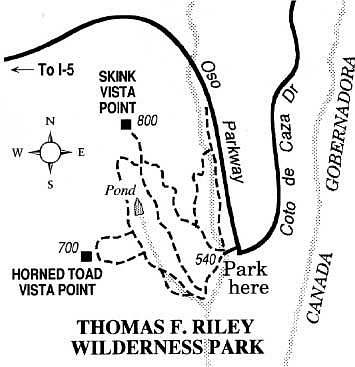 Facebook
Facebook
 X
X
 Instagram
Instagram
 TikTok
TikTok
 Youtube
Youtube
Orange County's Thomas F. Riley Wilderness Park -- a wilderness in name only -- spreads over 475 acres of rolling hills and oak-lined ravines and includes about five miles of trails open to hikers, equestrians, and mountain bikers. Like much of south Orange County, the area including and surrounding the park used to host many more cattle than people. A boom in housing construction during the past decade helped push Orange County's population over that of San Diego County -- and much of that construction has taken (and continues to take) place here. Increasingly, the park will assume the role of an island of open space in a sea of suburban sprawl.
Finding Riley Wilderness Park is easy. Simply take the Oso Parkway exit from Interstate 5 and drive six miles east to the park's entrance on the right. Park hours are 7 a.m. to sunset; a small fee is charged for parking your car.
The following moderately easy trek around the park's perimeter is rewarding. From the parking lot, head north on oak-shaded Wagon Wheel Canyon Trail, which runs parallel to Oso Parkway. After 0.4 mile, turn left, cross the shallow bottom of Wagon Wheel Canyon, and double back south on Pheasant Run Trail. After a gentle rise and a fall you arrive at the Mule Deer Trail, nearly back at the starting point. Make a sharp right and start climbing again. The late winter and early spring season brings forth a good display of wildflowers on the grassy hillsides ahead: shooting stars, lupine, wild hyacinth, and monkey flower. Later in the spring, blooming mustard paints yellow patches across these slopes.
The crooked climb on the Mule Deer Trail leads toward a ridgetop trail junction. Skink Vista Point, offering a somewhat wider view of the park and its surroundings, lies on the bald ridgeline a little higher and farther north of that junction. Jog left a little and turn right, starting a short and sharp descent into a shallow valley. Proceed south down the valley past an old stock pond, noting the sign for Horned Toad Vista Point on the right. The short and steep side trip up through aromatic sage-scrub vegetation is worth it; from the top of the trail you can gaze down on the most pristine and secluded parts of the park.
Returning to the previous trail, turn right and descend toward the oak- and sycamore-dotted floor of the valley. By staying right at all subsequent junctions you will return to the parking lot, approaching it from the south.


Orange County's Thomas F. Riley Wilderness Park -- a wilderness in name only -- spreads over 475 acres of rolling hills and oak-lined ravines and includes about five miles of trails open to hikers, equestrians, and mountain bikers. Like much of south Orange County, the area including and surrounding the park used to host many more cattle than people. A boom in housing construction during the past decade helped push Orange County's population over that of San Diego County -- and much of that construction has taken (and continues to take) place here. Increasingly, the park will assume the role of an island of open space in a sea of suburban sprawl.
Finding Riley Wilderness Park is easy. Simply take the Oso Parkway exit from Interstate 5 and drive six miles east to the park's entrance on the right. Park hours are 7 a.m. to sunset; a small fee is charged for parking your car.
The following moderately easy trek around the park's perimeter is rewarding. From the parking lot, head north on oak-shaded Wagon Wheel Canyon Trail, which runs parallel to Oso Parkway. After 0.4 mile, turn left, cross the shallow bottom of Wagon Wheel Canyon, and double back south on Pheasant Run Trail. After a gentle rise and a fall you arrive at the Mule Deer Trail, nearly back at the starting point. Make a sharp right and start climbing again. The late winter and early spring season brings forth a good display of wildflowers on the grassy hillsides ahead: shooting stars, lupine, wild hyacinth, and monkey flower. Later in the spring, blooming mustard paints yellow patches across these slopes.
The crooked climb on the Mule Deer Trail leads toward a ridgetop trail junction. Skink Vista Point, offering a somewhat wider view of the park and its surroundings, lies on the bald ridgeline a little higher and farther north of that junction. Jog left a little and turn right, starting a short and sharp descent into a shallow valley. Proceed south down the valley past an old stock pond, noting the sign for Horned Toad Vista Point on the right. The short and steep side trip up through aromatic sage-scrub vegetation is worth it; from the top of the trail you can gaze down on the most pristine and secluded parts of the park.
Returning to the previous trail, turn right and descend toward the oak- and sycamore-dotted floor of the valley. By staying right at all subsequent junctions you will return to the parking lot, approaching it from the south.
